For those who dont know the differecne between class 1 and calss 11 equipment.
"What is the difference between Class 1 and Class 2 electrical safety?
Class I Equipment is protectively earthed. All conductive parts are connected to an Earth Wire that has a continuous circuit through to the Earth Pin on the plug. All Appliance Testers will carry out this test. Class II Equipment is Double Insulated and does is not required to be earthed."
The question is do you need to earth solar panels and why, considering they are class 11 equipment.
Then the next question would be if they are class 11 equipment why you would need to bond a metal roof because you have fitted, considering the leads and solar wire is also double insulated and generally fitting in a PVC raceway. Some would say any roof with a supply connection to the roof would require it to be earthed and bonded.
What are your thoughts on this topic.
We all know what the regualtions state, I can copy and paste a bunch of regualtion from the SANS if thats what you need a quick, but I want to hear your thought on this topic.
"What is the difference between Class 1 and Class 2 electrical safety?
Class I Equipment is protectively earthed. All conductive parts are connected to an Earth Wire that has a continuous circuit through to the Earth Pin on the plug. All Appliance Testers will carry out this test. Class II Equipment is Double Insulated and does is not required to be earthed."
The question is do you need to earth solar panels and why, considering they are class 11 equipment.
Then the next question would be if they are class 11 equipment why you would need to bond a metal roof because you have fitted, considering the leads and solar wire is also double insulated and generally fitting in a PVC raceway. Some would say any roof with a supply connection to the roof would require it to be earthed and bonded.
What are your thoughts on this topic.
We all know what the regualtions state, I can copy and paste a bunch of regualtion from the SANS if thats what you need a quick, but I want to hear your thought on this topic.





Comment